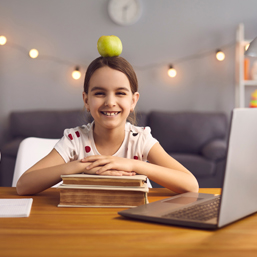
During the pandemic, I had the opportunity to take a leave from the school system and spend a couple of years running a home-based preschool program with my two youngest children, and support my older daughter while she was working remotely. Throughout that time, I made many connections with alternative schooling moms, and thanks to social media, have had the opportunity to get a glimpse into so many beautiful indoor and outdoor home-based learning spaces.
Creating environments that actually work to foster learning and academic success has always been of great interest to me. Back in 2010, when I first started exploring the Reggio Emilia philosophy of teaching, I was intrigued by the concept of the environment as the third teacher. Through this lens, a learning space is intended to be functional, beautiful, and reflective of the child’s learning, and can have a big impact on engagement and academic achievement.
Being a teacher, I’ve obviously transferred much of this knowledge into my classroom, but during the pandemic, also to my home learning space. Here are some ideas that you might implement in your homeschool that could help your little learners be more successful:
Accessible materials
Items like pencils, sharpies, scissors, paint and other tools for learning should be made available for children to access independently. As daunting as seeing your child reach for that gluestick may be, this accessibility helps them build confidence and autonomy, as well as develop their creativity. Another bonus? The more independence they have with their materials, the more ownership they build and in the long run, the more careful they are with them (you might even find yourself saying “put the cover back on that marker” a few times less than you used to!).
Bring the outdoors in
Materials from the outside are an organic way to provoke children to explore and think about the natural world. You can start simple by adding rocks, plants, flowers and wooden items to your learning space. These materials create a natural calming appeal, as well as help to keep colors neutral and not over-stimulating. One of my favorite ways to bring the outdoors in? Plant, grow and study your own greenery!
Keep it tidy
Keeping learning spaces minimalist, clean and well organized can eliminate distractions for young children, and can contribute to better productivity, creativity and efficiency. In keeping with the “outdoors in” concept, I like using natural materials like woven baskets and small wooden planters to store art materials. Rotating toys, a few books at a time and other small play-based materials also helps keep clutter to a minimum and encourages children to think more deeply about the objects provided to them.
Child-curated
It can be tempting to hang colorful posters, anchor charts and bright objects around the learning space, but try to let that be the child’s job. Not only can you add a pop of color with their favorite artwork or photograph, but kids can help create important learning resources too. For example, I love having students make the alphabet by gluing small loose-parts like dried legumes, rocks and popcorn onto tracer sheets and then hanging these up as reference tools for writing practice. From experience, when students create their own resources, it makes them feel ownership and increases how frequently they actually use them.
Get outside
Remember that your learning space isn’t limited to the walls of your playroom or home office. Create fluidity between interior and exterior by taking learning into the great outdoors as much as possible! Children thrive when learning outside and many studies show it increases motivation, concentration, environmental awareness, enhanced mood and self-confidence.
In closing, keep in mind that along with teacher, student and content, the environment can have a huge impact on our child’s academic success and overall engagement in learning. Do you need to change everything about your home learning space? Absolutely not. But try out one or two of these tips over the next few months and see what you notice about your child’s learning!
References:
Malaguzzi, L. (1996). The Hundred Languages of Children: The Reggio Emilia Approach to Early Childhood Education. New Jersey: Ablex Publishing Corporation.
Ashley is a mom of three, early childhood educator, and elementary teacher. She has a Master’s Degree (Instructional Leadership) from the University of Calgary and loves inspiring families, educators, and caregivers to help their children learn at home and school. For more ideas, follow her on Facebook and Instagram (@teachthemlittle).
See our related articles:
Calgary’s Child Magazine © 2024 Calgary’s Child